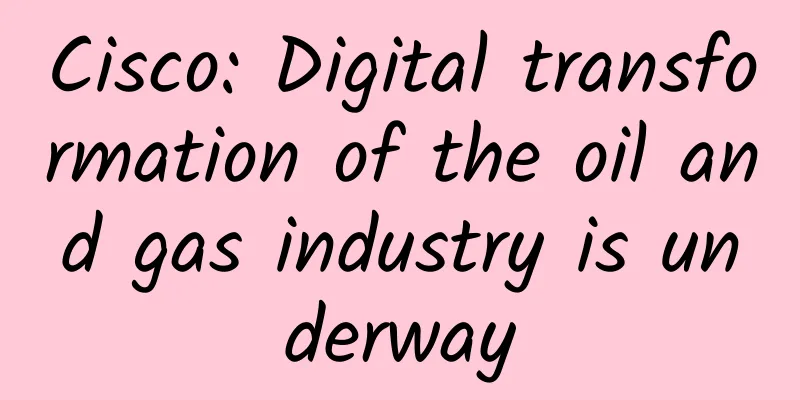Cisco: Digital transformation of the oil and gas industry is underway

|
199IT original compilation When it comes to energy exploration, "drill and drill" is a simple slogan, but the oil and gas industry (O&G) has long gone beyond the simple drilling model and introduced digital information processing. For example, the integrated production model was introduced in the 1970s. In the recent turmoil in the energy industry, oil and gas companies are more focused on investing in intelligence to improve work efficiency. Forward-looking companies are committed to true digital transformation, using the Internet of Everything to connect people, processes, data and things throughout the industry's value chain. According to a recent survey by Cisco, of these four elements, data is the most needed and the most in need of improvement. Respondents believe that data related to the Internet of Everything is most in need of improvement in order to increase insights and value. However, in many cases, there is no lack of data; oil and gas companies are full of sensors and machines at every production terminal, generating a large amount of data. The real challenge is the ability to capture and analyze data in real time and use the results to improve production and operations. To fully utilize the extensive data generated by the Internet of Everything, oil and gas companies must overcome three obstacles:
Automated data collection : By extending cloud computing and services to fog computing, enterprises can take advantage of real-time data analysis and emerging IoT applications. For example, an offshore oil platform generates 1TB to 2TB of data every day. Most of the data is time-sensitive and related to platform production and safety. Using the most commonly used satellite connection, it takes 12 days to transfer a day's data to a central repository. But with fog computing, enterprises can evaluate data locally, decide which data needs to be transmitted to the data center, and analyze the data at the edge of the network. Edge computing has many applications and is particularly useful in industries such as oil and gas, where multiple sensors can be deployed at remote terminals. Integrating data : Integrating data is particularly challenging when it comes from disparate sources, such as embedded sensors, cameras, and third-party data sources. Many companies now use data virtualization to make a set of heterogeneous data sources appear to be a single database, regardless of format or location, eliminating the need to centralize all data into physical storage. Integration is only required when users request data from multiple different sources. This "integration on demand" gives users instant access to all the data they need. Traditionally, oil and gas companies have used manual processes to collect and integrate data. Data virtualization can provide a single view of a well and all of its components, allowing for faster, more efficient, and more profitable actions. Analyze data : Whether in the cloud or at the edge, IoT data must be analyzed to gain actionable insights. These insights need to be incorporated into practical efforts such as process reengineering and broader business transformation. To maximize the use of data, oil and gas companies need tools to increase the volume, velocity, variety and distribution of data, as well as employees with data science and design skills who understand the structure of the enterprise. Data analysis can bring many beneficial benefits, including improving the ability to make quick decisions. In order to provide real value, data insights must be connected to specific business processes and outcomes. Respondents see the potential of data analytics as driving important business outcomes. They cite "data analytics for faster and better decision making," "improving operational efficiency," and "increasing productivity" as the top three drivers for investing in technologies like the Internet of Everything. Digital transformation requires oil and gas companies to make the Internet of Everything more hyper-sensitive, more predictive and more agile, and data analysis and data management capabilities are also necessary. These play a vital role in driving the value of oil and gas companies. Therefore, the new slogan should become "drill, data, and drill again." 199IT.com Originally compiled from: Cisco. Please do not reprint without authorization |
<<: Juniper Research: Global 5G revenue is expected to exceed US$65 billion in 2025
>>: Where will the next big battle between Apple and Google be?
Recommend
With an idle rate of up to 70%, why have small household appliances become the “bottom of the box”?
In the past few days, Ms. Liu cleaned her house a...
German quality, reciprocating double blade heads, Xiaomi Braun electric shaver redefines men's charm
Someone once said that Mijia's products never...
With an efficiency of 75%, the photography industry can double the click-through rate of information flow advertising by doing this!
As costume photography is sought after by more an...
What kind of platform is Juliang Qianchuan?
What is Juliang Qianchuan? Bytedance Qianchuan is...
With thinner legs and more rounded buttocks, why do men have better figures than women?
Have you noticed a seemingly unreasonable phenome...
How to promote Juliang Qianchuan and what is the promotion effect of Juliang Qianchuan?
With the launch of the massive Qianchuan platform...
New car-making forces challenge the Shanghai Auto Show. What are their backgrounds?
Compared with previous years, one of the highligh...
Short video operation data analysis method!
In the previous sharing, we focused on the produc...
It's true that there are more OLED TVs available now, but are they right for you?
Apple iPhone finally uses OLED display for the fi...
"Iris photography" suddenly became popular! Is it safe? Doctors warn...
Recently, a new type of "iris photo" ha...
Brand KOL marketing and growth!
Internet celebrities are the leverage of products...
2021 Information Feed Advertising Trends: Video Materials
This article will talk to you about the video mat...
Volkswagen closes German factory, Blume is willing to "get a speeding ticket" to enter the Chinese time
"The situation is very serious." This i...
Don't buy this kind of dried flowers for indoor decoration! It's illegal!
During the New Year, everyone likes to buy some N...
Norovirus is entering its peak period! How to prevent it?
China Science and Technology News Network, Februa...









![Analysis of mainstream [information flow advertising] channels, the war is about to break out!](/upload/images/67cc4595e5648.webp)